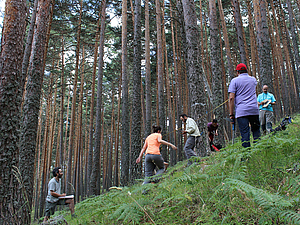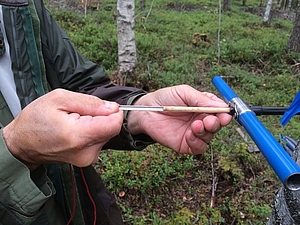
GenTree uses a multi-scale tree sampling scheme to study gene flow and the role of genetic diversity and environmental variability in shaping adaptive traits in trees - traits that enhance the fitness and survival of individuals and have evolved by means of selection.
For each of seven species investigated in the project, trees are sampled in ten sites across Europe, from as far south as Spain and as far northeast as Lithuania. In each site, a pair of populations is selected, located at the two opposite ends of a specific ecological gradient. The two populations in a pair consist of 25 trees each and grow under contrasting ecological conditions but are connected by gene flow. On top of that, 10 plots of 25 trees (usually inside genetic conservation units) are investigated for other five species.
Simple maths highlights the impressive scale of this experiment: 120 sampling sites, 190 populations and a total of 4750 trees! That requires a lot of coordination among research teams. They first choose the sites and describe their ecology in detail. Then they collect leaves and needles from the higher parts of the canopy either by climbing the tree or by using other devices and core the trunks to extract wood samples. Finally, they send the collected material to three central laboratories for analyses: Italy for DNA analyses, Spain for ecophysiological analyses and Switzerland for wood analyses.

To harmonize sampling procedures across sites and to ensure the practices adopted were well aligned with international legislation, a protocol was developed. It has been used to guide field teams in how to select the most appropriate site, what characteristics of the site to record and what traits of the individual trees and of the wood and leaf samples to measure. The protocol describes how to prepare the collected material so that it can be properly processed: leaves have to be fresh and intact for DNA sequencing and wood cylinders should be stored in particular containers that help preserve the sample until it is fully analyzed.
The sampling has progressed steadily since June 2016, but not without challenges and adventures. Lars Opgenoorth from the University of Marburg (Germany) shared the hardships of coring black poplar in August, with some notes from the field:
It is a great pleasure given all the mosquitos, and the sheer size of the trees (and sheer size of my arms as a result of mosquito bites!…).
I had difficulties never experienced with other species that I cored before. Many cores broke after ca. 1-2 cm. I varied the duration of the pressure put on the core via the borer - between a couple of turns and up to 20 turns. This did not seem to produce any result.
Many of the poplars are extremely wet inside - in the sense that they really spill water - sometimes like a faucet - when the core is extracted. Apart from the smell and the somewhat sticky mess it creates, the real issue is that the cores expand and become extremely fragile, so it is sometimes hard to put them into their tubes in one piece.
The site located in a meadow is largely affected by a complex hydrological dynamics. Thus, trees do not grow straight; this is also caused by the fact that often a stump has more than 1 large stem, each looking for light and space. As a consequence, the choice of what individual to sample is not straightforward.
To avoid being squirted by poplars, some teams postponed coring until the growing season is over. The lessons learnt on the ground contributed to the constant refinement of the protocol, which is now in its 87th version, soon to be published.
A field workshop to test one of the intermediary versions of the sampling protocol took place on 10 June 2016 on Mont Ventoux (France), one of the GenTree project sampling sites. The following project partners participated in the field visit: Aristotle University of Thessaloniki (AUTH), Greece; Agencia Estatal Consejo Superior de Investigaciones Científicas (CSIC), Spain; the Institut National de la Recherche Agronomique (INRA), France; the Philipps-Universität Marburg (PUM), Germany; and the Swiss Federal Institute for Forest, Snow and Landscape Research (WSL), Switzerland.